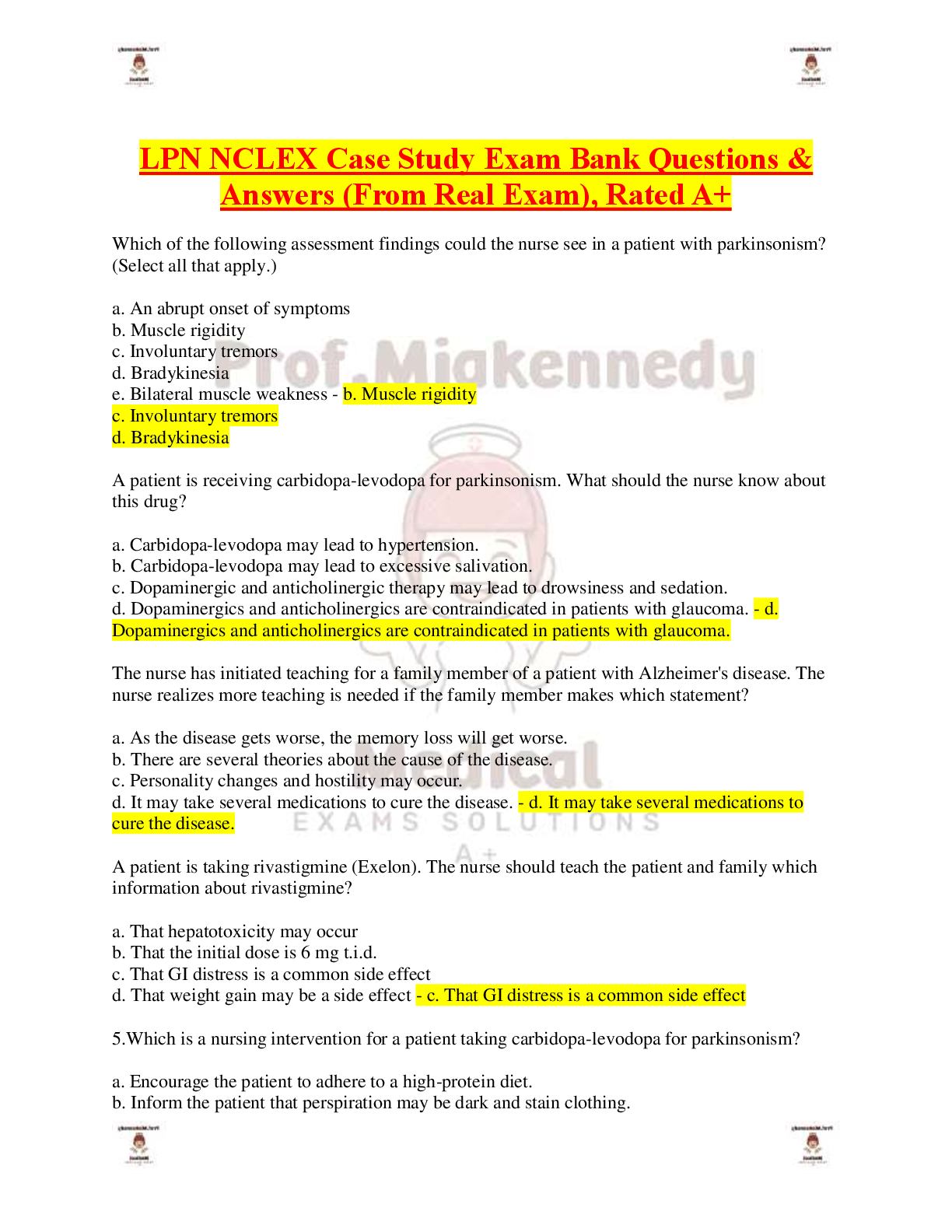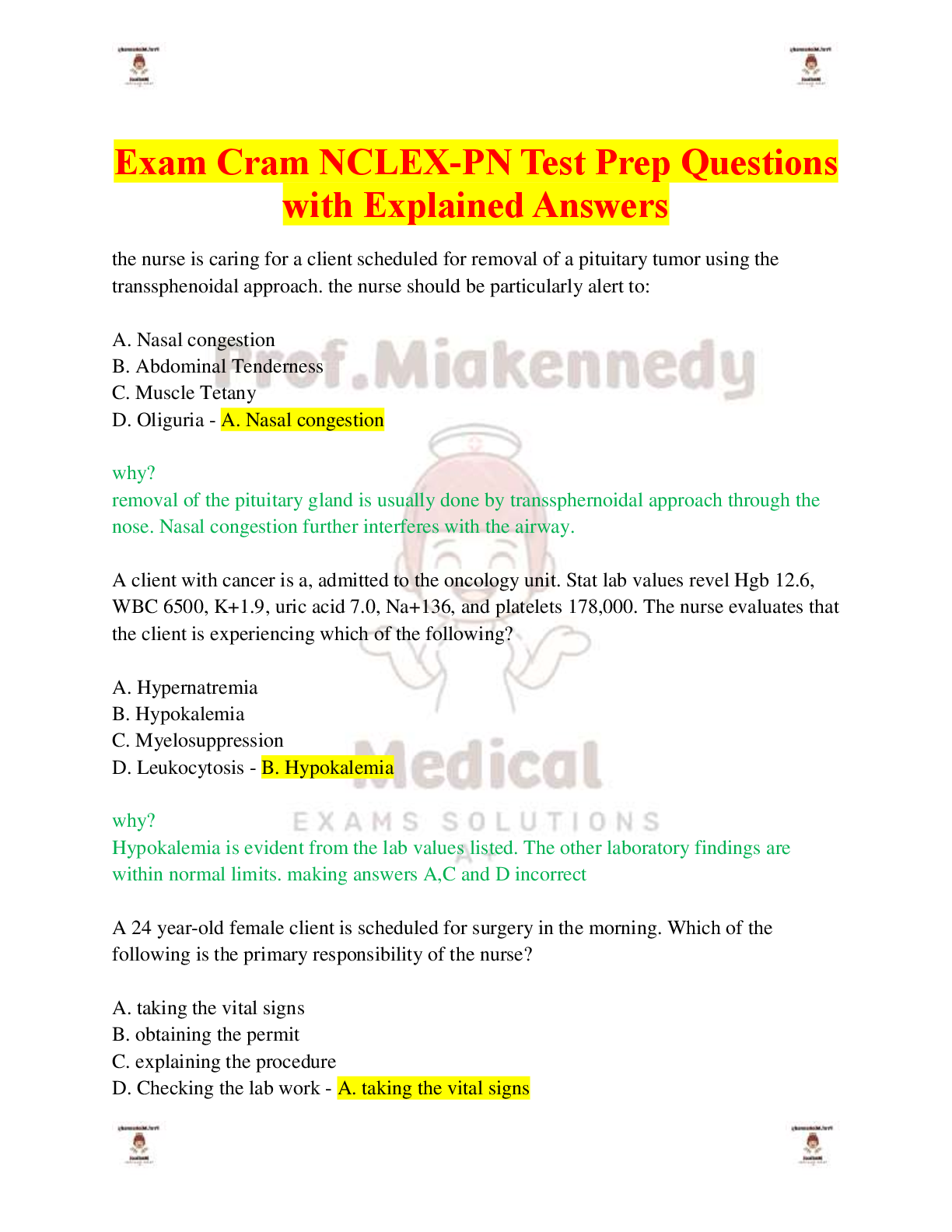*NURSING > NCLEX-PN > LPN NCLEX Case Study Exam Bank Questions & Answers (From Real Exam), Rated A+ (All)
LPN NCLEX Case Study Exam Bank Questions & Answers (From Real Exam), Rated A+
Document Content and Description Below
LPN NCLEX Case Study Exam Bank Questions & Answers (From Real Exam), Rated A+,Which of the following assessment findings could the nurse see in a patient with parkinsonism? (Select all that apply.) ... a. An abrupt onset of symptoms b. Muscle rigidity c. Involuntary tremors d. Bradykinesia e. Bilateral muscle weakness - b. Muscle rigidity c. Involuntary tremors d. Bradykinesia A patient is receiving carbidopa-levodopa for parkinsonism. What should the nurse know about this drug? a. Carbidopa-levodopa may lead to hypertension. b. Carbidopa-levodopa may lead to excessive salivation. c. Dopaminergic and anticholinergic therapy may lead to drowsiness and sedation. d. Dopaminergics and anticholinergics are contraindicated in patients with glaucoma. - d. Dopaminergics and anticholinergics are contraindicated in patients with glaucoma. The nurse has initiated teaching for a family member of a patient with Alzheimer's disease. The nurse realizes more teaching is needed if the family member makes which statement? a. As the disease gets worse, the memory loss will get worse. b. There are several theories about the cause of the disease. c. Personality changes and hostility may occur. d. It may take several medications to cure the disease. - d. It may take several medications to cure the disease. A patient is taking rivastigmine (Exelon). The nurse should teach the patient and family which information about rivastigmine? a. That hepatotoxicity may occur b. That the initial dose is 6 mg t.i.d. c. That GI distress is a common side effect d. That weight gain may be a side effect - c. That GI distress is a common side effect 5.Which is a nursing intervention for a patient taking carbidopa-levodopa for parkinsonism? a. Encourage the patient to adhere to a high-protein diet. b. Inform the patient that perspiration may be dark and stain clothing. c. Advise the patient that glucose levels should be checked with urine testing. d. Warn the patient that it may take 4 to 5 days before symptoms are controlled. - b. Inform the patient that perspiration may be dark and stain clothing. What would the nurse teach a patient who is taking anticholinergic therapy for parkinsonism? (Select all that apply.) a. Avoid alcohol, cigarettes, and caffeine. b. Relieve dry mouth with hard candy or ice chips. c. Use sunglasses to reduce photophobia. d. Urinate 2 hours after taking the drug. e. Receive routine eye examinations. - a. Avoid alcohol, cigarettes, and caffeine. A patient is taking rivastigmine (Exelon) to improve cognitive function. What should the nurse teach the patient/family member to do? (Select all that apply.) a. Rise slowly to avoid dizziness. b. Remove obstacles from pathways to avoid injury. c. Closely follow the drug dosing schedule. d. Have frequent checks for hypertension. e. Receive regular liver function tests. - a. Rise slowly to avoid dizziness. b. Remove obstacles from pathways to avoid injury. c. Closely follow the drug dosing schedule. Your client has a fracture of the radius. There is swelling at the injury site and the client complains of pain in the area. Which stage of bone healing do these signs and symptoms represent? a. Cellular proliferation b. Inflammatory c. Ossification d. Callus formation - b. Inflammatory During the inflammatory phase, bleeding occurs at the area of injury and results in a hematoma. Why plus I was rushed to the area of injury to begin to debride the dead cells. The patient will experience pain during this phase. Cellular proliferation occurs after approximately 5 days, when the interrupted blood supply is recreated and fibrin strands begin to form. The callus formation stage takes about 3 to 4 weeks, while the ossification stage may take as long as 3 to 4 months. Remodeling of the bone may take months to years. Who was the English Quaker who advocated humane care and built an asylum to reflect a household? a. Florence Nightingale b. William Tukes c. Sigmund Freud d. Benjamin Rush - b. William Tukes Changes in the delivery of mental health care that resulted from the development of electroconvulsive therapy and psychotherapeutic drugs brought about which phenomenon in the 20th century? a. Behavioral therapy b. Personality disorganization c. Deinstitutionalization d. Brain surgery - c. Deinstitutionalization What is the best description of personality? a. The level of mental health that a person attains in life b. The relatively consistent set of attitudes and behaviors particular to an individual c. The result of a positive self-concept and acceptable behavior d. The ability to manage stress - b. The relatively consistent set of attitudes and behaviors particular to an individual The nurse is reviewing the assessment finding for a patient hospitalized with a stress disorder. What findings support the diagnoses? a. A vague feeling of depression b. An assumed role to protect the ego c. A main reason for all mental illnesses d. A response to any demand made upon the individual - d. A response to any demand made upon the individual The nurse is caring for a patient who is currently voicing feelings of anxiety. The nurse correctly recognizes what as the best description of the feelings that the patient is experiencing? a. A vague feeling of apprehension b. Feelings of paranoia c. Concerns about the impressions others have for her d. Emotional stability - a. A vague feeling of apprehension An assembly line manager in a factory was told that he would be laid off if his line did not meet the hourly quote. He promptly went to his workers and threatened to fire anyone who was found taking even 1 minute extra on a break. What is the manager displaying? a. Denial b. Regression c. Displacement d. Identification - c. Displacement Punishment and abandonment were how mentally ill people were treated in medieval times. These practices continued until the 17th and 18th centuries. Which care practice that is still being used today did Dr. Phillipe Pinel of France advocate? a. Electroshock therapy for melancholy b. Humane care with record keeping of behaviors c. Psychoanalysis d. Home care in the community - b. Humane care with record keeping of behaviors The student nurse is working on a presentation regarding OBRA. What was the result of this landmark legislation? a. Deinstitutionalization b. Approved surgical treatment for schizophrenia c. Prohibition of electroshock therapy d. Increased construction of state facilities for residential mental health care - a. Deinstitutionalization A 52-year old patient experienced cardiac arrest from a myocardial infarction. During his acute care stay in the hospital, the patient flirts with all female nurses. When he is asked to stop, he withdraws and later complains of chest heaviness. What is a possible explanation for the patient's behavior? a. Boredom from restricted activity b. Lack of motivation to recover c. Frustration from illness d. Threatened self-concept - d. Threatened self-concept A 14-year-old tells the school nurse that she is self-conscious about her recent breast development. She reports that the boys in her class are teasing her. What is the first step for the nurse to take? a. Call her parents b. Have her describe what happened c. Ask who her friends are d. Provide her with a pamphlet outlining the changes associated with puberty - b. Have her describe what happened Your patient with heart failure has been responding well to treatments that include medications such as ACE inhibitors and a loop diuretic. Today, the client is complaining about leg weakness and is refusing to ambulate. What is most likely occurring with this client? a. Hyperkalemia b. Hyponatremia c. Hypokalemia d. Hypernatremia - c. Hypokalemia Hypokalemia, or low potassium, often occurs as the result of treatments with loop diuretics like furosemide (Lasix). The signs and symptoms of hypokalemia include muscular weakness, pain and cramping, as well as serious cardiac dysrhythmias. Clients taking loop diuretics should be closely monitored for hypokalemia and also given potassium supplementation when indicated. Which of the following assistive techniques should the be used to transfer a patient who can bear weight from the bed to the chair? a. mechanical lift b. slide transfer c. pivot transfer d. assisted transfer - c. pivot transfer Your client is to have an NG tube inserted. To mark the tube prior to insertion, you should: a. place the tip of the tube at the corner of the patient's eye and extend the tip to the earlobe, and then to the tip of the xiphoid process. b. place the tip of the tube at the corner of the mouth and extend the tip to the top of the patient's ear, and then to the umbilicus. c. place the tip of the tube at the patient's nostril and extend the tip of the earlobe, and then to the tip of the xiphoid process. d. place the tip of the tube at the patient's nostril , extend it to the tip of the earlobe, and then to the base of the ribcage. - c. place the tip of the tube at the patient's nostril and extend the tip of the earlobe, and then to the tip of the xiphoid process. A patient with a history of alcohol abuse is arrested for driving under the influence. His wife bails him out of jail for the third time. His wife's response is an example of: a. attachement disorder b. reactivity c. codependency d. addiction - c. codependency A nurse has performed a non stress test on a pregnant client and is reviewing the fetal monitoring strip. The nurse interprets the test as reactive and understands that this indicates which of the following? a. the need for further evaluation b. abnormal findings c. that the findings on the monitor were difficult to interpret d. normal findings - d. normal findings A reactive non stress test is a normal test. To be considered reactive, the baseline fetal heart rate must be within normal range (120-160 BPM) with good long term viability. Your client is in active labor at 41 weeks. The membranes rupture and you note that the fluid is thick and green in color. This is indicative of: a. blood b. infected amniotic fluid c. normal amniotic fluid d. meconium - d. meconium Amniotic fluid that is stained a greenish color and is thickened contains meconium, the newborn's first stool. This is a warning sign of potential fetal distress. The physician should be notified, and the newborn may require tracheal suctioning immediately following delivery. [Show More]
Last updated: 2 weeks ago
Preview 1 out of 121 pages

Buy this document to get the full access instantly
Instant Download Access after purchase
Buy NowInstant download
We Accept:

Also available in bundle (1)

BUNDLE: LPN-NCLEX 2025-2026 EXAM SETS & TESTBANK, ALL RATED A+, Answered
BUNDLE: LPN-NCLEX 2025-2026 EXAM SETS & TESTBANK, ALL RATED A+, Answered
By PROF 2 weeks ago
$30.5
3
Reviews( 0 )
$17.50
Can't find what you want? Try our AI powered Search
Document information
Connected school, study & course
About the document
Uploaded On
Jul 16, 2025
Number of pages
121
Written in
Additional information
This document has been written for:
Uploaded
Jul 16, 2025
Downloads
0
Views
11




